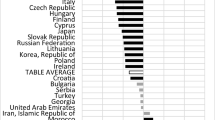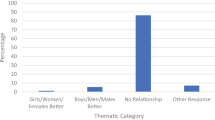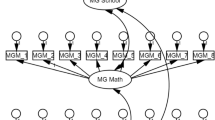Abstract
The previous chapter is somehow continued to this chapter entitled “Educational models and differences between groups of 16-year-old students in gender, motivation and achievements in chemistry” by Devetak and Glažar who described other aspects of students’ characteristics using statistical analysis of numerous variables regarding triple nature of chemical concepts presentations. Students can be differentiated into groups during classroom activities also according to their abilities, academic achievements, and interests. On the basis of these classifications students can be engaged in specific learning tasks. Different models can be formed according to students’ academic achievements, motivation for a specific subject, gender, and also other variables that can influence classroom dynamics. Three predictive educational models developed by discriminant analysis are presented. This rather complicated statistical analysis can show that teachers should be aware that girls need more attention in chemistry learning than boys. Teachers should extrinsically motivate using macroscopic level of chemical concepts and put those concepts into the context for those students who are low achievers in physics and have low intrinsic motivation for learning chemistry.
Access this chapter
Tax calculation will be finalised at checkout
Purchases are for personal use only
Similar content being viewed by others
References
Ainsworth, S. (1999). The functions of multiple representations. Computers & Education, 33(2–3), 131–152.
Anderman, E. M., & Young, A. J. (1994). Motivation and strategy use in science: Individual differences and classroom effects. Journal of Research in Science Teaching, 31(8), 811–831.
Becker, N., Rasmussen, C., Sweeney, G., Wawro, M., Towns, M., & Cole, R. (2013). Reasoning using particulate nature of matter: An example of a sociochemical norm in a university-level physical chemistry class. Chemistry Education Research and Practice, 14(1), 81–94.
Bryman, A. (2004). Social research methods. New York: Oxford University Press.
Bunce, D. M., & Gabel, D. (2002). Differential effects in the achievement of males and females of teaching the particulate nature of chemistry. Journal of Research in Science Teaching, 39(10), 911–972.
Chittleborough, G. D., Treagust, D. F., & Mocerino, M. (2002). Constraints to the Development of First Year University Students’ Mental Models of Chemical Phenomena. Teaching and Learning Teaching and Learning Forum 2002: Focusing on the Student. Retrieved January 30, 2004, from http://www.ecu.edu.au/conferences/tlf/2002/pub/docs/Chittleborough.pdf
Coll, R. K., Dalgety, J., & Salter, D. (2002). The development of the chemistry attitudes and experiences questionnaire (CAEQ). Chemistry education; Research and practice in. Europe, 3(1), 19–32.
Davidowitz, B., Chittleborough, G., & Murray, E. (2010). Student-generated submicro diagrams: A useful tool for teaching and learning chemical equations and stoichiometry. Chemistry Education Research and Practice, 11(3), 154–164.
de Berg, K. (2012). A study of first-year chemistry students’ understanding of solution concentration at the tertiary level. Chemistry Education Research and Practice, 13(1), 8–16.
Devetak, I., & Glažar, S. A. (2010a). The influence of 16-year-old students’ gender, mental abilities, and motivation on their reading and drawing submicrorepresentations achievements. International Journal of Science Education, 32(12), 1561–1593.
Devetak, I., & Glažar, S. A. (2010b). Approach to developing the learning to learn strategy in chemistry. In M. Valenčič Zuljana & J. Vogrinc (Eds.), Facilitating effective student learning through teacher research and innovation (pp. 399–414). Ljubljana: Faculty of Education.
Devetak, I., Drofenik Lorber, E., Juriševič, M., & Glažar, S. A. (2009a). Comparing Slovenian year 8 and year 9 elementary school pupils’ knowledge of electrolyte chemistry and their intrinsic motivation. Chemistry Education Research and Practice, 10(4), 281–290.
Devetak, I., Vogrinc, J., & Glažar, S. A. (2009b). Assessing 16-year-old students’ understanding of aqueous solution at submicroscopic level. Research in Science Education, 39(2), 157–179.
diSessa, A. A. (2004). Metarepresentation: Native competence and targets for instruction. Cognition and Instruction, 22(3), 293–331.
Gilbert, J. K., & Treagust, D. F. (2009). Towards a coherent model for macro, submicro and symbolic Representations in chemical education. In J. K. Gilbert & D. F. Treagust (Eds.), Multiple representations in chemical education (pp. 333–350). Dortrecht: Springer.
Green, S. B., Salkind, N. J., & Akey, T. M. (2000). Using SPSS for windows: Analyzing and understanding data. Englewood Cliffs, NJ: Prentice Hall.
Haidar, A. H., & Abraham, M. R. (1991). A comparison of applied and theoretical knowledge of concepts based on the particulate nature of matter. Journal of Research in Science Teaching, 28(10), 919–938.
Halakova, Z., & Prokša, M. (2007). Two kinds of conceptual problems in chemistry teaching. Journal of Chemical Education, 84(1), 172–174.
Johnson, P. (1998). Children’s understanding of changes of state involving the gas state, Part II: Evaporation and condensation below boiling point. International Journal of Science Education, 20(6), 695–709.
Juriševič, M., Devetak, I., Razdevšek-Pučko, C., & Glažar, S. A. (2008). Intrinsic motivation of pre-service primary school teachers for learning chemistry in relation to their academic achievement. International Journal of Science Education, 30(1), 87–107.
Keig, P. F., & Rubba, P. A. (1993). Translation of representations of structure of matter and its relationship to reasoning, gender, spatial reasoning, and specific prior knowledge. Journal of Research in Science Teaching, 30(8), 883–903.
Kelly, R. M., & Jones, L. L. (2008). Investigating students’ ability to transfer ideas learned from molecular animations of the dissolution process. Journal of Chemical Education, 85(2), 303–309.
Kern, A. L., Wood, N. B., Roehrig, G. H., & Nyachwaya, J. (2010). A qualitative report of the ways high school chemistry students attempt to represent a chemical reaction at the atomic/molecular level. Chemistry Education Research and Practice, 11(3), 165–172.
Lee, K.-W. L. (1999). A comparison of university lecturers’ and pre-service teachers’ understanding of a chemical reaction at the particulate level. Journal of Chemical Education, 76(7), 1008–1012.
Longden, K., Black, P., & Solomon, J. (1991). Children’s interpretation of dissolving. International Journal of Science Education, 13(1), 59–68.
Meece, J. L., & Jones, M. G. (1996). Gender differences in motivation and strategy use in science: Are girls rote learners? Journal of Research in Science Teaching, 33(4), 393–406.
Moore, R. W., & Foy, R. L. (1997). The scientific attitude inventory: A revision (SAIII). Journal of Research in Science Teaching, 34(4), 327–336.
Mulford, D. R., & Robinson, W. R. (2002). An inventory for alternative conceptions among first-semester general chemistry students. Journal of Chemical Education, 79(6), 739–744.
Nieswandt, M. (2007). Students affect and conceptual understanding in learning chemistry. Journal of Research in Science Teaching, 44(7), 908–937.
Pallant, J. (2005). SPSS survival manual. Berkshire: Open University Press.
Papageorgiou, G., & Johnson, P. (2005). Do particle ideas help or hinder pupils’ understanding of phenomena? International Journal of Science Education, 27(11), 1299–1317.
Pogačnik, V. (1998). Test hitrosti percepcije “Vzorci”. Center za psihodiagnostična sredstva: Priročnik. Ljubljana.
Pogačnik, V. (2000). Osebna izkaznica testa—Spacialni test Rotacije. Ljubljana: Center za psihodiagnostična sredstva.
Prain, V., & Waldrip, B. (2006). An exploratory study of teachers’ and students’ use of multi-modal representations of concepts in primary science. International Journal of Science Education, 28(15), 1843–1866.
Ramnarain, U., & Joseph, A. (2012). Learning difficulties experienced by grade 12 South African students in the chemical representation of phenomena. Chemistry Education Resesearch and Practice, 13(4), 462–470.
Rennie, L. J. (1990). Student participation and motivational orientation: What do students do in science? In K. Tobin, J. Butler, & B. J. Fraser (Eds.), Windows into science classrooms: Problems associated with higher-level cognitive learning (pp. 164–198). London: The Falmer Press.
Russell, T., & McGuigan, L. (2001). Promoting understanding through representational redescription: An illustration referring to young pupils’ ideas about gravity. Paper presented at the 3rd International Conference of the ESERA, Thessaloniki.
Ryan, R. M., & Deci, E. L. (2000). Intrinsic and extrinsic motivation: Classic definitions and new directions. Contemporary Educational Psychology, 25(1), 54–67.
Sanger, M. J., & Phelps, A. J. (2007). What are students thinking when they pick their answer? A content analysis of students’ explanations of gas properties. Journal of Chemical Education, 84(5), 870–874.
Simpson, R. D., & Oliver, J. S. (1990). A summary of major influences on attitude toward and achievement in science among adolescent students. Science Education, 74(1), 1–18.
Solsona, N., Izquierdo, M., & De Jong, O. (2003). Exploring the development of students’ conceptual profiles of chemical change. International Journal of Science Education, 25(1), 3–12.
Stains, M., & Talanquer, V. (2007). Classification of chemical substances using particulate representations of matter: An analysis of students’ thinking. International Journal of Science Education, 29(5), 643–661.
Stains, M., & Talanquer, V. (2008). Classification of chemical reactions: Stages of expertise. Journal of Research in Science Teaching, 45(7), 771–793.
Steinkamp, M. (1984). Motivational style as a mediator of adult achievement in science. In M. Steinkamp & M. Maehr (Eds.), Advances in motivation and achievement 2 (pp. 281–316). Greenwich, CT: JAI Press.
Stipek, D. (1998). Motivation to learn: From theory to practice. Boston: Allyn and Bacon.
Thiele, R. B., & Treagust, D. F. (1994). An interpretative explanation of high School chemistry teachers’ analogical explanations. Journal of Research in Science Teaching, 31(3), 227–242.
Tien, L. T., Teichert, M. A., & Rickey, D. (2007). Effectiveness of a more laboratory module in prompting students to revise their molecular-level ideas about solutions. Journal of Chemical Education, 84(2), 175–180.
Tobin, K. G., & Capie, W. (1981). The development and validation of a group test of logical thinking. Educational and Psychological Measurement, 41(2), 413–423.
Treagust, D. F., Harrison, A. G., & Venville, G. J. (1998). Teaching science effectively with analogies: An approach for preservice and inservice teacher education. Journal of Science Teacher Education, 9(1), 85–101.
Tuan, H. L., Chin, C. C., & Shieh, S. H. (2005). The development of a questionnaire to measure students’ motivation towards science learning. International Journal of Science Education, 27(6), 639–654.
Waldrip, B., Prain, V., & Carolan, J. (2006). Learning junior secondary science through multi-modal representations. Electronic Journal of Science Education, 11. Retrieved June 30, 2007, from http://ejse.southwestern.edu/volumes/v11n1/articles/art06_waldrip.pdf
Williamson, V. M., & Abraham, M. R. (1995). The effects of computer animation on the particulate mental models of college chemistry students. Journal of Research in Science Teaching, 32(5), 521–534.
Wu, H. K., & Shah, P. (2004). Exploring visuospatial thinking in chemistry learning. Science Education, 88(3), 465–492.
Zusho, A., Pintrich, P. R., & Coppola, B. (2003). Skill and will: The role of motivation and cognition in the learning of college chemistry. International Journal of Science Education, 25(9), 1081–1094.
Author information
Authors and Affiliations
Corresponding author
Editor information
Editors and Affiliations
Appendices
Appendix 1: Sample Items from the Diagnostic Instrument for Determining Chemical Knowledge (CK)


Appendix 2: Sample Items from the Questionnaire Intrinsic Motivation for Learning Science (IMLS)
1. Emotional component of intrinsic motivation:
I enjoy learning.
I am often bored during the:
… chemistry course.
… biology course.
… physics course.
… foreign language course.
… mathematics course.
I enjoy the chemistry course when:
… we observe chemical changes in experiments.
… we learn about particles (atoms, ions, and molecules).
… we learn and write chemical symbols, formulae, and equations.
2. Cognitive component of intrinsic motivation:
I often look for additional information about school science topics in books, magazines, on the Internet, CDs …
The media attract my attention when reporting on:
…chemistry topics.
…biology topics.
…physics topics.
…foreign language topics.
…mathematics topics.
I often think about:
…observation of chemical changes in experiments, also out of school.
… particles (atoms, ions, molecules), also out of school.
…learning and writing chemical symbols, formulae and equations, also out of school.
3. Challenge component of intrinsic motivation:
I persevere with learning.
New problems in:
… chemistry, challenge me.
… biology, challenge me.
… physics, challenge me.
… foreign language, challenge me.
… mathematics, challenge me.
If I do not understand something, connected with:
… observation of chemical changes in experiments, I give up.
… learning about particles (atoms, ions, and molecules), I give up.
… learning and writing chemical symbols, formulae, and equations, I give up.
Rights and permissions
Copyright information
© 2014 Springer Science+Business Media B.V.
About this chapter
Cite this chapter
Devetak, I., Glažar, S.A. (2014). Educational Models and Differences between Groups of 16-year-old Students in Gender, Motivation, and Achievements in Chemistry. In: Devetak, I., Glažar, S. (eds) Learning with Understanding in the Chemistry Classroom. Springer, Dordrecht. https://doi.org/10.1007/978-94-007-4366-3_6
Download citation
DOI: https://doi.org/10.1007/978-94-007-4366-3_6
Published:
Publisher Name: Springer, Dordrecht
Print ISBN: 978-94-007-4365-6
Online ISBN: 978-94-007-4366-3
eBook Packages: Humanities, Social Sciences and LawEducation (R0)




